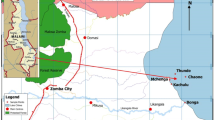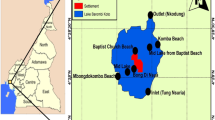Abstract
We report results from an evaluation of the levels of heavy metals, i.e., copper (Cu), cadmium (Cd), lead (Pb), nickel (Ni), manganese (Mn), chromium (Cr), and iron (Fe) in sediment and tilapia fish samples from a wide stretch of the Kafue river of Zambia. In sediment samples, the highest Pb and Fe concentrations were recorded at Hippo Dam, i.e., 36.2 ± 0.1 mg/kg dw and 733 ± 37 mg/kg dw at Kafue Town, respectively. Other notably high metal concentrations in sediment were Cr at Kafue Bridge (42.5 ± 0.1 mg/kg dw [dw]), Cu at Mpongwe (233 ± 5 mg/kg dw), and Mn at Kafue Town (133 ± 1 mg/kg dw); it was highest at Ithezi Tezhi Dam at 166 ± 1 mg/kg d. Three fish species, i.e., three-spot bream Tilapia andersonii, red-breasted bream T. rendalli, and nile tilapia Oreochromis niloticus were evaluated for levels of the seven metals. The concentrations of the metals in these fish species afforded estimation of the biota sediment-accumulation factor, which is the ratio of the concentration of the metal in liver to that in the sediment. The coefficients of condition (K) values, which give an indication of the health of the fish, were also estimated. The K values ranged from 2.5 ± 0.5 to 5.1 ± 0.6 in all of the three fish species. Partial least squares analysis showed that heavy metals are generally sequestered evenly in all of the parts of all of the three fish species except for elevated levels of Mn, Cd, and Pb in the liver samples.
Similar content being viewed by others
References
Abdallah MAM, Abdallah AMA (2008) Biomonitoring study of heavy metals in biota and sediments in the South Eastern Coast of Mediterranean Sea, Egypt. Environ Monit Assess 146:139–145
Choongo KC, Syakalima MS, Mwase M (2005) Coefficient of condition in relation to copper levels in muscle of serranochromis fish and sediment from the Kafue River, Zambia. Bull Environ Contam Toxicol 75(4):645–651
Duruibe JO, Ogwuegbu MOC, Egwurugwu JN (2007) Heavy metal pollution and human biotoxic effects. Int J Phys Sci 2(5):112–118
European Union (2006) Setting maximum levels for certain contaminants in foodstuffs, (2006). Commission regulation (EC) no. 1881. Off J Eur Union 364:5–24
Falusi BA, Olanipekun EO (2007) Bioconcentration factors of heavy metals in tropical crab (carcinus sp) from River Aponwe, Ado-Ekiti, Niger. J Appl Sci Environ Manag 11:51–54
Fianko JR, Osae S, Adomako D, Adotey DK, Serrfor-Armah Y (2007) Assessment of heavy metal pollution of the Iture estuary in the central region of Ghana. Environ Monit Assess 131:467–473
Food and Agricultural Organization (1983) Compilation of legal limits for hazardous substances in fish and fishery products. FAO Fishery Circular No. 764
Getachew T, Fernando CH (1989) The food habits of an herbivorous fish (Oreochromis niloticus Linn.) in Lake Awasa, Ethiopia. Hydrobiologia 174:195–200
Hillier Stockwell, Mills White (2001) World mineral statistics 1995-99. British Geological Survey, Nottingham
Ikenaka Y et al (2010) Heavy metal contamination of soil and sediment in Zambia. Afr J Environ Sci Technol 4(11):729–739
Khallaf E, Galal M, Athuman M (2003) The biology of Oreochromis niloticus in a polluted canal. Ecotoxicology 12:405–416
MacGregoer JS (1959) Relation between fish condition and population size in the sardine (Sardinops cacrulea). Fish Wild Ser 60:215–230
Mwase M, Viktor T, Norrgren L (1998) Effects on tropical fish of soil sediments from Kafue river, Zambia. Bull Environ Contam Toxicol 61(1):96–101
Nakayama SMM, Ikenaka Y, Muzandu K, Choongo K, Oroszlany B et al (2010) Heavy metal accumulation in lake sediments, fish (Oreochromis niloticus and Serranochromis thumbergi), and crayfish (Cherax quadricarinatus) in Lake Tezhi-tezhi and Lake kariba. Arch Environ Contam Toxicol 59(2):291–300
Nakayama SMM et al (2011) Metal and metalloid contamination in roadside soil and wild rats around a Pb–Zn mine in Kabwe, Zambia. Environ Pollut 159(1):175–181
Nehemia A, Maganira JD, Rumisha C (2012) Length-weight relationship and condition factor of tilapia species grown in marine and fresh water ponds. Agric Biol J N Am 3:117–124
Norrgren L, Pettersson UT, Orns S, Bergqvist PA (2000) Environmental monitoring of the Kafue River: Zambia using caged three spot Tilapia (Oreochromis andersonii). Arch Environ Contam Toxicol 38:334–341
Syakalima MS, Choongo KC, Chilonda P, Ahmadu B, Mwase M, Onuma M et al (2001) Bioaccumulation of lead in wildlife dependent on the contaminated environment of the Kafue Flats. Arch Environ Contam Toxicol 67:438–445
Tembo BD, Sichilongo K, Cernak J (2006) Distribution of copper, lead, cadmium and zinc concentrations in soils around Kabwe town in Zambia. Chemosphere 63(3):497–501
The National Academies Press (1997–2005) Dietary reference intakes for Vitamin a, Vitamin k, arsenic, boron, chromium, copper, iodine, iron, manganese, molybdenum, nickel, silicon, vanadium, and zinc
United States Department of Energy (1998) Biota sediment accumulation factors for invertebrates: review and recommendations for the Oak Ridge Reservation BJC/OR-112. http://www.esd.ornl.gov/programs/ecorisk/documents/bjcor-112a1.pdf. Accessed: June 10, 2015
Acknowledgments
The authors thank the Copperbelt University of Zambia and the University of Botswana for material support.
Author information
Authors and Affiliations
Corresponding author
Rights and permissions
About this article
Cite this article
Mbewe, G., Mutondo, M., Maseka, K. et al. Assessment of Heavy-Metal Pollution in Sediments and Tilapia Fish Species in Kafue River of Zambia. Arch Environ Contam Toxicol 71, 383–393 (2016). https://doi.org/10.1007/s00244-016-0295-3
Received:
Accepted:
Published:
Issue Date:
DOI: https://doi.org/10.1007/s00244-016-0295-3








